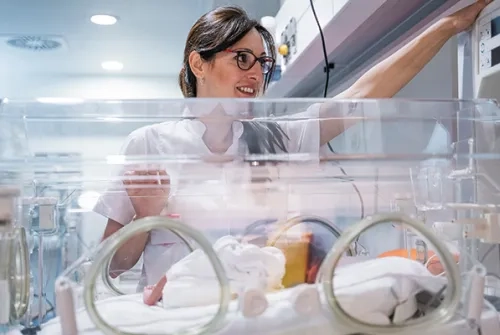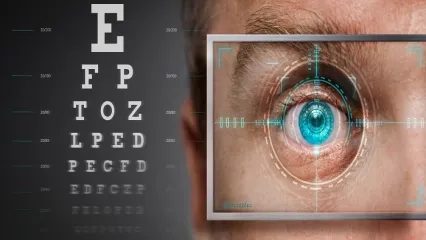Alo Yeditepe
Alo Yeditepe
A Common But Little-Known Disease: Retinopathy of Prematurity (ROP)
Retinopathy of prematurity (ROP) is one of the important health problems that can develop in the eyes of premature babies and threaten vision. Pointing out that the earlier the baby is born, the higher the risk of ROP will be, Assoc. Prof. Dr. Özge Yabaş Kızıloğlu gave important information about retinopathy of prematurity.
The retina is the tissue at the back of the inner part of the eye that detects light and enables vision. Stating that retinopathy of prematurity (ROP) is a disease in which the blood vessels in the retinas of premature babies develop abnormally and that it can result in blindness, Ophthalmology Specialist Assoc. Prof. Dr. Özge Yabaş Kızıloğlu drew attention to the necessity of timely and regular eye examinations of premature babies.
Eye Diseases Department about this problem faced by preterm babies. Specialist Assoc. Prof. Dr. Özge Yabaş Kızıloğlu gave the following information:
“Retinal vascularization, which starts in the mother's womb at approximately the 16th week of pregnancy, progresses from the middle of the retina to the outermost parts until the 40th week, which is the normal birth time of the baby. In the case of premature birth, the baby is born before the retinal vascularization process is completed. The earlier the baby was born, the larger the retinal area is not vascularized. After birth, depending on the general condition of the baby, the degree of prematurity, intensive care conditions, and some risk factors related to lung development, the vascularization process may continue and be completed in its normal way, or normal vascularization is interrupted and abnormal vessels develop and ROP emerges.
Occurs in 1 of Every 4 Babies Screened
Highlighting that according to a multicenter study conducted in our country and published in the British Journal of Ophthalmology in 2018, retinopathy of prematurity (ROP) is seen in 1 out of every 4 babies screened for retinopathy of prematurity, Assoc. Prof. Dr. Yabaş Kızıloğlu stated that the development of serious ROP requiring treatment is 6.7 percent, according to the said study.
Stating that; "All babies who are at risk for retinopathy of prematurity should be examined by an ophthalmologist trained in this subject," Assoc. Prof. Dr. Kızıloğlu said, “This examination is called screening. Although the first screening examination varies according to the birth week of the baby, it should usually be done when the baby is 4 weeks old.
Stating that the criteria determining which babies will be screened for ROP vary from country to country, Assoc. Prof. Dr. Özge Yabaş Kızıloğlu said that all babies with a gestational age of fewer than 34 weeks or a birth weight of 1700 grams and below are screened for the development of ROP, in line with the Turkish Guidelines for Retinopathy of Prematurity published as a result of the studies of the Turkish Neonatology Society and the Turkish Ophthalmology Society.
If Treatment Is Required, It Should Be Applied As Soon As Possible!
Pointing out that only one screening examination may be sufficient in some babies, however, in most babies, it is necessary to repeat the examination with varying frequencies depending on the severity of the disease, until the normal vascularization of the retina is completed, Associated Prof. Dr. Özge Yabaş Kızıloğlu gave the following information:
“For example, in mild cases, the examination is performed at intervals of 1-2 weeks and the disease regresses on its own and normal vascularization is completed. In more severe cases, the examination may be required at intervals of 1 week or less. The disease that requires treatment is very rare. If these cases are recognized in time and treated as soon as possible, negative consequences such as vision loss and blindness can often be successfully prevented. The most effective treatment is to prevent the development of abnormal blood vessels in the retina with a laser. Anti-VEGF drugs can be injected into the eye in some aggressive disease cases,
Regular Eye Examinations Should Not Be Ignored!
Ophthalmology Specialist Assoc. Prof. Dr. Özge Yabaş Kızıloğlu reminded us that the incidence of eye problems such as high myopia, astigmatism, strabismus, amblyopia, glaucoma, and retinal detachment in babies with retinopathy of prematurity, especially those treated for severe ROP, is higher than the normal population and therefore pointed out that regular eye examinations should be continued in the following years.
Press Coverage: trthaber | cnnturk | star | haberler | gazetevatan | sabah | AA | yeniasir
About
Faculty and Year of Graduation:
Istanbul University Faculty of Medicine, 2000
”
See Also
- Damages of Fake Sunglasses
- What is Cataract? Symptoms and Treatment
- Get Your Child's Eye Examination Done Before They Go to School!
- Pay Attention to the Flashing Light in the Eye!
- Medication Administration to the Eye
- Glaucoma
- The Danger to the World: MYOPIA
- Are Flies Flying Before Your Eyes?
- Eye Problems Increase as Children's Digital Screen Time Extends
Alo Yeditepe




